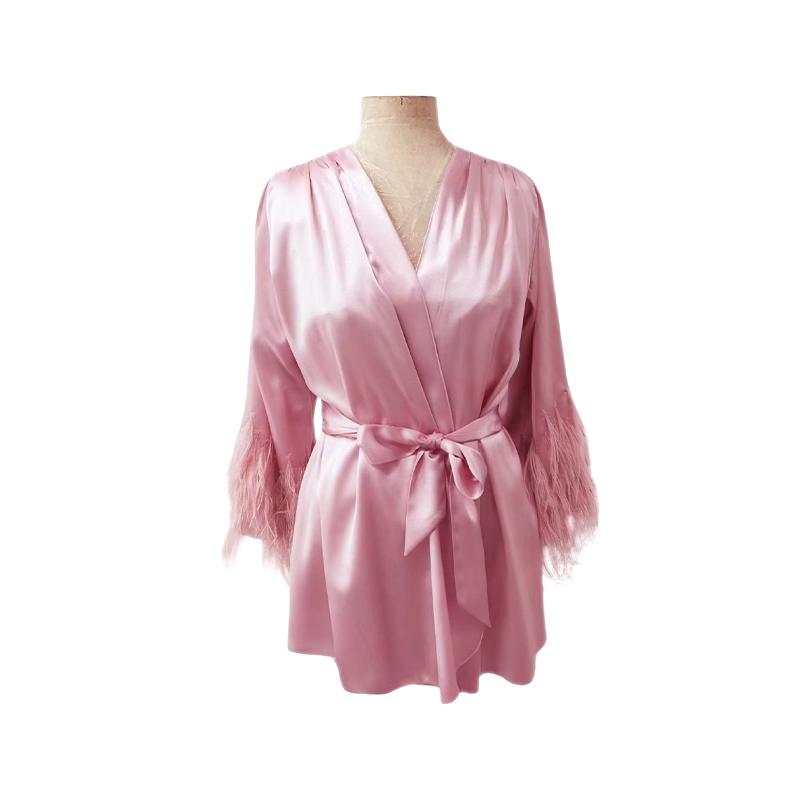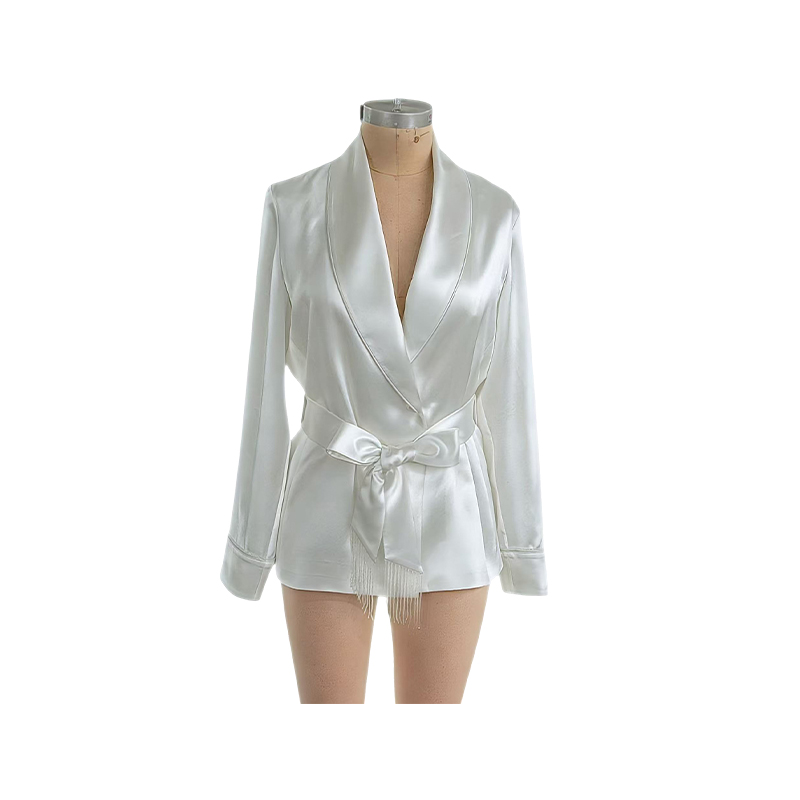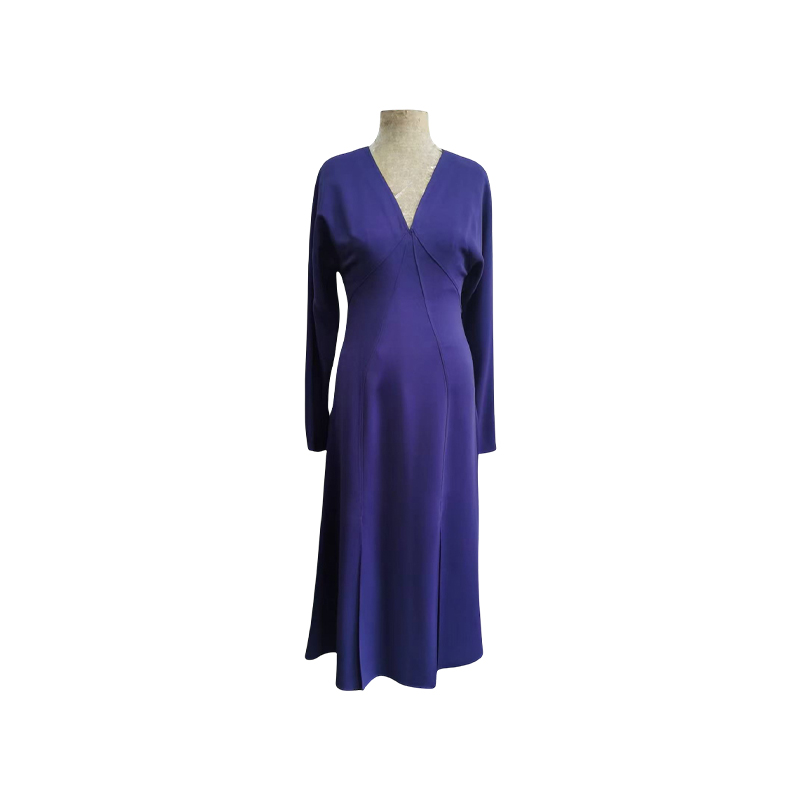How do silk women's pajamas achieve a dry, breathable, and comfortable feel all night?
Release Time : 2025-11-04
In the pursuit of quality sleep, the choice of underwear is often underestimated, yet it profoundly affects comfort and skin condition throughout the night. Especially in warm and humid seasons, or for those sensitive to temperature changes, pajamas that cannot regulate moisture and heat can easily lead to stickiness, stuffiness, and even awakenings during the night. So how do silk women's pajamas achieve a dry, breathable, and comfortable feel all night? The answer lies in the natural microstructure and unique physical properties of silk fibers—it doesn't rely on powerful sweat-wicking, but rather on a gentle and intelligent approach, achieving a delicate balance with the body's microenvironment.
Silk is composed of natural silk protein, whose fiber cross-section has a triangular or porous structure. This natural "microchannel" gives the fabric excellent moisture absorption and release capabilities. When the body naturally releases moisture during sleep, silk can quickly absorb the moisture close to the skin's surface, temporarily locking it inside the fibers to prevent sweat from accumulating on the skin and creating a sticky feeling. When ambient humidity decreases or body temperature adjusts slightly, this moisture is easily released into the air, achieving dynamic regulation. This "absorption-release" cycle doesn't rely on chemical additives but stems from the material's inherent breathing mechanism, making it long-lasting and effective without diminishing with washing.
More importantly, silk's moisture-wicking process is extremely gentle. Unlike some synthetic fibers that create a "dry illusion" by rapidly wicking away sweat, it regulates humidity at a gentle pace, preventing skin from feeling tight or dry due to sudden water loss. This delicate humidity management is particularly suitable for prolonged nighttime wear, keeping skin in an ideal state of "slightly moist but not damp, dry but not astringent."
Breathability stems from the lightweight and loose structure of silk fabric. High-quality silk women's pajamas often use satin or twill weaves, with a smooth surface but tiny internal gaps allowing air to circulate freely. This structure ensures a flowing, draping aesthetic while creating natural microcirculation channels, preventing heat buildup and allowing for continuous exchange of fresh air. Even in a drafty, enclosed bedroom, silk, thanks to the natural gaps between its fibers, maintains good airflow, effectively preventing stuffiness.
Furthermore, silk possesses natural temperature-regulating capabilities. In cool environments, its low thermal conductivity creates a layer of still air, providing gentle warmth; in warm environments, its dense fibers and lightweight fabric quickly dissipate heat, resulting in a cool touch. This dual-mode temperature control allows silk women's pajamas to adapt to seasonal changes, especially during the transition from spring to summer or in air-conditioned rooms, avoiding discomfort caused by temperature fluctuations.
It's worth noting that silk's surface is as smooth as water, with an extremely low coefficient of friction. When tossing and turning at night or moving, there is almost no pulling sensation between the clothing and the skin, reducing irritation to delicate skin and preventing localized overheating caused by friction. For women with long hair, silk also reduces friction between hair and pillowcases or collars, reducing frizz and tangles, indirectly improving the sleep experience.
Of course, this dry and breathable effect relies on proper care. While silk is delicate, its natural properties can be preserved for a long time as long as it is protected from direct sunlight, strong alkaline washing, and high-temperature ironing. A well-cared-for silk women's pajamas becomes softer and more conforming to the body's rhythm with each wear.
In summary, silk women's pajamas achieve a comfortable experience of staying dry and cool all night long through the natural moisture-wicking properties of its fibers, the lightweight and breathable structure of the fabric, and its gentle temperature control. It is understated yet silently protects the tranquility of every inch of skin. In the quiet of the night, wearing silk feels like being enveloped in moonlight-woven clouds—light, clean, and free—this is not only an enjoyment of sleep but also a daily ritual of gentle self-care.
Silk is composed of natural silk protein, whose fiber cross-section has a triangular or porous structure. This natural "microchannel" gives the fabric excellent moisture absorption and release capabilities. When the body naturally releases moisture during sleep, silk can quickly absorb the moisture close to the skin's surface, temporarily locking it inside the fibers to prevent sweat from accumulating on the skin and creating a sticky feeling. When ambient humidity decreases or body temperature adjusts slightly, this moisture is easily released into the air, achieving dynamic regulation. This "absorption-release" cycle doesn't rely on chemical additives but stems from the material's inherent breathing mechanism, making it long-lasting and effective without diminishing with washing.
More importantly, silk's moisture-wicking process is extremely gentle. Unlike some synthetic fibers that create a "dry illusion" by rapidly wicking away sweat, it regulates humidity at a gentle pace, preventing skin from feeling tight or dry due to sudden water loss. This delicate humidity management is particularly suitable for prolonged nighttime wear, keeping skin in an ideal state of "slightly moist but not damp, dry but not astringent."
Breathability stems from the lightweight and loose structure of silk fabric. High-quality silk women's pajamas often use satin or twill weaves, with a smooth surface but tiny internal gaps allowing air to circulate freely. This structure ensures a flowing, draping aesthetic while creating natural microcirculation channels, preventing heat buildup and allowing for continuous exchange of fresh air. Even in a drafty, enclosed bedroom, silk, thanks to the natural gaps between its fibers, maintains good airflow, effectively preventing stuffiness.
Furthermore, silk possesses natural temperature-regulating capabilities. In cool environments, its low thermal conductivity creates a layer of still air, providing gentle warmth; in warm environments, its dense fibers and lightweight fabric quickly dissipate heat, resulting in a cool touch. This dual-mode temperature control allows silk women's pajamas to adapt to seasonal changes, especially during the transition from spring to summer or in air-conditioned rooms, avoiding discomfort caused by temperature fluctuations.
It's worth noting that silk's surface is as smooth as water, with an extremely low coefficient of friction. When tossing and turning at night or moving, there is almost no pulling sensation between the clothing and the skin, reducing irritation to delicate skin and preventing localized overheating caused by friction. For women with long hair, silk also reduces friction between hair and pillowcases or collars, reducing frizz and tangles, indirectly improving the sleep experience.
Of course, this dry and breathable effect relies on proper care. While silk is delicate, its natural properties can be preserved for a long time as long as it is protected from direct sunlight, strong alkaline washing, and high-temperature ironing. A well-cared-for silk women's pajamas becomes softer and more conforming to the body's rhythm with each wear.
In summary, silk women's pajamas achieve a comfortable experience of staying dry and cool all night long through the natural moisture-wicking properties of its fibers, the lightweight and breathable structure of the fabric, and its gentle temperature control. It is understated yet silently protects the tranquility of every inch of skin. In the quiet of the night, wearing silk feels like being enveloped in moonlight-woven clouds—light, clean, and free—this is not only an enjoyment of sleep but also a daily ritual of gentle self-care.







